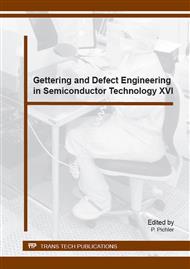[1]
G. Coletti, Sensitivity of state-of-the-art and high efficiency crystalline silicon solar cells to metal impurities, Prog. Photovoltaics, vol. 21, no. 5, pp.1163-1170, (2013).
DOI: 10.1002/pip.2195
Google Scholar
[2]
C. V. Ciobanu, C. -Z. Wang, and K. -M. Ho, Atomic Structure Prediction of Nanostructures, Clusters and Surfaces. Germany: Wiley, (2013).
Google Scholar
[3]
T. A. Arias and J. D. Joannopoulos, Electron trapping and impurity segregation without defects: Ab initio study of perfectly rebonded grain boundaries, Phys. Rev. B, vol. 49, no. 7, p.4525, (1994).
DOI: 10.1103/physrevb.49.4525
Google Scholar
[4]
A. A. Istratov, T. Buonassisi, R. McDonald, A. Smith, R. Schindler, J. Rand, J. P. Kalejs, and E. R. Weber, Metal content of multicrystalline silicon for solar cells and its impact on minority carrier diffusion length, J. Appl. Phys., vol. 94, no. 10, pp.6552-6559, (2003).
DOI: 10.1063/1.1618912
Google Scholar
[5]
G. Coletti, R. Kvande, V. D. Mihailetchi, L. J. Geerligs, L. Arnberg, and E. J. Øvrelid, Effect of iron in silicon feedstock on p-and n-type multicrystalline silicon solar cells, J. Appl. Phys., vol. 104, no. 10, p.104913, (2008).
DOI: 10.1063/1.3021355
Google Scholar
[6]
D. MacDonald, A. Cuevas, A. Kinomura, Y. Nakano, and L. Geerligs, Transition-metal profiles in a multicrystalline silicon ingot, J. Appl. Phys., vol. 97, no. 3, p.033523, (2005).
DOI: 10.1063/1.1845584
Google Scholar
[7]
M. Sanati, N. G. Szwacki, and S. K. Estreicher, Interstitial fe in si and its interactions with hydrogen and shallow dopants, Phys. Rev. B, vol. 76, no. 12, p.125204, (2007).
DOI: 10.1103/physrevb.76.125204
Google Scholar
[8]
M. Rumler, M. Rommel, J. Erlekampf, M. Azizi, T. Geiger, A. J. Bauer, E. Meißner, and L. Frey, Characterization of grain boundaries in multicrystalline silicon with high lateral resolution using conductive atomic force microscopy, J. Appl. Phys., vol. 112, no. 3, p.034909, (2012).
DOI: 10.1063/1.4746742
Google Scholar
[9]
M. Y. Chou, M. L. Cohen, and S. G. Louie, Theoretical study of stacking faults in silicon, Phys. Rev. B, vol. 32, no. 12, p.7979, (1985).
DOI: 10.1103/physrevb.32.7979
Google Scholar
[10]
K. Uchida and S. Tsuneyuki, Theoretical investigation on the electronic states localized at grain boundaries in semiconductors, Appl. Surf. Sci., vol. 190, no. 1, pp.129-133, (2002).
DOI: 10.1016/s0169-4332(01)00855-8
Google Scholar
[11]
J. Chen, T. Sekiguchi, D. Yang, F. Yin, K. Kido, and S. Tsurekawa, Electron-beam-induced current study of grain boundaries in multicrystalline silicon, J. Appl. Phys., vol. 96, no. 10, pp.5490-5495, (2004).
DOI: 10.1063/1.1797548
Google Scholar
[12]
R. Jones and P. R. Briddon, The ab initio cluster method and the dynamics of defects in semiconductors, ser. Semiconductors and Semimetals. Boston: Academic Press, 1998, vol. 51A, ch. 6.
DOI: 10.1016/s0080-8784(08)63058-6
Google Scholar
[13]
C. Hartwigsen, S. Goedecker, and J. Hutter, Relativistic separable dual-space gaussian pseudopotentials from H to Rn, Phys. Rev. B, vol. 58, no. 7, p.3641, (1998).
DOI: 10.1103/physrevb.58.3641
Google Scholar
[14]
J. P. Goss, M. J. Shaw, and P. R. Briddon, Marker-method calculations for electrical levels using gaussian-orbital basis sets, Topics in Appl. Phys., vol. 104, p.69, (2007).
DOI: 10.1007/11690320_4
Google Scholar
[15]
M. Rayson and P. Briddon, Highly efficient method for kohn-sham density functional calculations of 500-10 000 atom systems, Phys. Rev. B, vol. 80, no. 20, p.205104, (2009).
DOI: 10.1103/physrevb.80.205104
Google Scholar
[16]
H. J. Monkhorst and J. D. Pack, Special points for Brillouin-zone integrations, Phys. Rev. B, vol. 13, no. 12, pp.5188-5192, (1976).
DOI: 10.1103/physrevb.13.5188
Google Scholar
[17]
G. Henkelman, B. P. Uberuaga, and H. J´onsson, A climbing image nudged elastic band method for finding saddle points and minimum energy paths, J. Chem. Phys., vol. 113, no. 22, pp.9901-9904, (2000).
DOI: 10.1063/1.1329672
Google Scholar
[18]
H. Muller, M. Tuynman, G. Sieverts, and C. Ammerlaan, Electron paramagnetic resonance on ironrelated centers in silicon, Phys. Rev. B, vol. 25, no. 1, p.25, (1982).
DOI: 10.1103/physrevb.25.25
Google Scholar
[19]
H. Takahashi, M. Suezawa, and K. Sumino, Charge-state-dependent activation energy for diffusion of iron in silicon, Phys. Rev. B, vol. 46, pp.1882-1885, (1992).
DOI: 10.1103/physrevb.46.1882
Google Scholar
[20]
L. F. Mattheiss and J. R. Patel, Electronic stacking-fault states in silicon, Phys. Rev. B, vol. 23, no. 10, pp.5384-5396, (1981).
DOI: 10.1103/physrevb.23.5384
Google Scholar
[21]
B. Ziebarth, M. Mrovec, C. Els¨asser, and P. Gumbsch, Interstitial iron impurities at grain boundaries in silicon: A first-principles study, Phys. Rev. B, vol. 91, p.035309, (2015).
DOI: 10.1103/physrevb.91.035309
Google Scholar
[22]
M. Kohyama and R. Yamamoto, Tight-binding study of grain boundaries in si: Energies and atomic structures of twist grain boundaries, Phys. Rev. B, vol. 49, no. 24, p.17102, (1994).
DOI: 10.1103/physrevb.49.17102
Google Scholar
[23]
S. L. Altmann, A. Lapiccirella, K. W. Lodge, and N. Tomassini, A valence force field for the silicon crystal, J. Phys. C, vol. 15, no. 27, p.5581, (1982).
DOI: 10.1088/0022-3719/15/27/014
Google Scholar
[24]
M. C. Payne, P. D. Bristowe, and J. D. Joannopoulos, Ab initio determination of the structure of a grain boundary by simulated quenching, Phys. Rev. Lett., vol. 58, no. 13, p.1348, (1987).
DOI: 10.1103/physrevlett.58.1348
Google Scholar


